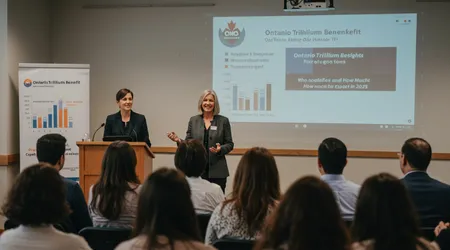Ontario Trillium Benefit Insights: Who Qualifies and How Much to Expect in 2025

Ontario Trillium Benefit payments are a lifeline for low- and moderate-income Ontarians, easing the sting of rising living costs.
In 2025, this tax-free support, administered by the Canada Revenue Agency (CRA), combines three credits Northern Ontario Energy Credit (NOEC), Ontario Energy and Property Tax Credit (OEPTC), and Ontario Sales Tax Credit (OSTC) to help residents manage energy bills, property taxes, and sales taxes.
With a 2.7% inflation adjustment kicking in July 2025, payments are set to rise, offering timely relief amid economic pressures.
This article unpacks eligibility, expected amounts, and practical tips to maximize your benefits, blending clarity with actionable insights. Why wouldn’t you want to ensure you’re getting every dollar you deserve?
The Ontario Trillium Benefit isn’t just a government handout it’s a strategic tool designed to level the financial playing field. For many, it’s the difference between covering rent or cutting back on groceries.
In 2025, with inflation still biting, the program’s role in supporting Ontarians is more critical than ever.
Whether you’re a renter in Toronto, a homeowner in Thunder Bay, or a senior in Ottawa, understanding this benefit can unlock significant savings.
Let’s dive into who qualifies, what you can expect, and how to avoid missing out.
Understanding the Ontario Trillium Benefit
The Ontario Trillium Benefit merges three tax credits into one streamlined payment. It targets low- and moderate-income households, offering monthly or lump-sum support.
The NOEC helps Northern Ontario residents with high energy costs, while the OEPTC offsets property taxes or rent. The OSTC cushions the blow of sales taxes for all eligible Ontarians.
Eligibility hinges on your 2024 tax return, filed by April 30, 2025. You must be an Ontario resident, 19 or older, and meet income thresholds.
For example, singles earning under $45,000 or families below $60,000 often qualify. Even if you don’t own a home, renters can claim the OEPTC based on rent paid.
Payments vary by credit, income, and location. In 2025, the CRA adjusts amounts annually based on the Ontario Consumer Price Index.
++ Pharmacare Is Coming: The First Phase of National Drug Coverage Launching in 2025
A 2024 report from the CRA noted 1.5 million Ontarians received OTB payments, underscoring its widespread impact. Filing taxes on time ensures uninterrupted benefits.
Missed payments often stem from incomplete tax filings. For instance, Jane, a Toronto renter, lost her 2024 OTB because she skipped the ON-BEN form.
Don’t let simple errors cost you double-check your return. The Ontario Trillium Benefit is your money; claim it.
Think of the OTB like a financial safety net, catching you when costs soar. Without it, many Ontarians would struggle with basic expenses. Stay proactive to secure your share of this vital support.

Who Qualifies for the Ontario Trillium Benefit in 2025?
To receive the Ontario Trillium Benefit, you must meet specific criteria. Residency in Ontario by June 1, 2025, is non-negotiable. You also need to be 19 or older, or have a spouse, common-law partner, or child living with you.
Income plays a pivotal role. The CRA assesses your 2024 adjusted net income to determine eligibility.
Singles with incomes below $45,000 and families under $60,000 typically qualify, though thresholds vary by credit. For NOEC, you must live in designated northern regions like Sudbury or Timmins.
Renters, homeowners, and seniors can all benefit. The OEPTC, for instance, supports those paying rent or property taxes, regardless of ownership status. Seniors over 65 may receive additional OEPTC boosts, easing fixed-income burdens.
Also read: Canada’s New Student CPP Benefit: Boosting Support for Part-Time Students in 2025
Consider Mark, a Thunder Bay retiree. His $30,000 pension qualifies him for NOEC and OEPTC, netting $500 annually. Filing his taxes early ensures he gets monthly payments. Delaying risks a lump-sum wait until June 2026.
Eligibility isn’t automatic you must file your taxes and complete Form ON-BEN. Errors, like omitting rent details, can disqualify you. Check CRA’s My Account to confirm your status and avoid surprises.
The Ontario Trillium Benefit rewards diligence. By meeting these criteria, you unlock funds to offset daily costs. Why risk missing out when a few steps secure your payment?
How Much Can You Expect in 2025?
Payment amounts for the Ontario Trillium Benefit depend on your income, family size, and location. In 2025, the 2.7% inflation adjustment boosts payouts, reflecting rising costs. The CRA calculates benefits based on your 2024 tax return.
Singles can receive up to $1,200 annually, while families may get up to $2,039, per CRA estimates.
Read more: How Canada’s New Childcare Subsidies Are Helping Families Thrive
NOEC offers up to $185 for singles and $285 for families in Northern Ontario. OEPTC ranges from $200 to $1,100, based on rent or property taxes paid.
Below is a table outlining maximum 2025 OTB credit amounts, adjusted for inflation:
| Credit | Single (Max) | Family (Max) |
|---|---|---|
| NOEC | $185 | $285 |
| OEPTC | $1,100 | $1,100 |
| OSTC | $360 | $654 |
| Total (Combined) | $1,645 | $2,039 |
If your total OTB is $360 or less, expect a lump-sum payment in July 2025. Amounts over $360 allow monthly payments, starting July 10. For example, a family in Sault Ste. Marie earning $50,000 might receive $150 monthly.
Income reductions can increase your benefit. If your 2024 income dropped from 2023, you could see higher payments. Conversely, a raise might lower your OTB. Always report accurate income to avoid overpayments.
Precision matters. Incorrect tax filings can skew your benefit. Use CRA’s online calculator to estimate your 2025 payout and plan your budget accordingly. The Ontario Trillium Benefit is a financial boost make it count.
How to Maximize Your Ontario Trillium Benefit
Securing the full Ontario Trillium Benefit requires strategy. First, file your 2024 taxes by April 30, 2025, including Form ON-BEN. Missing this deadline halts payments until June 2026.
Double-check your tax return for accuracy. List all rent or property taxes paid, as these boost OEPTC amounts. For NOEC, confirm your address qualifies as Northern Ontario. Errors here cost hundreds.
Set up direct deposit via CRA’s My Account for faster payments. Cheques take weeks, while direct deposits hit your account by the 10th monthly. Speed matters when bills pile up.
If your income or family status changed in 2024, update the CRA promptly. A new child or job loss can increase your OTB. Delaying updates risks underpayment.
Free tax clinics, offered by the CRA, help low-income filers avoid mistakes. In 2024, these clinics assisted 300,000 Canadians, per CRA data. Seek help if taxes feel daunting.
Like tuning a car for peak performance, optimizing your OTB takes effort. Stay proactive, and you’ll stretch every dollar further in 2025’s tough economy.
Economic Impact and Future Outlook
The Ontario Trillium Benefit isn’t just personal relief it fuels local economies. Recipients spend on groceries, utilities, and rent, boosting businesses. In 2024, OTB injected $2 billion into Ontario’s economy, per government estimates.
With inflation persisting in 2025, the 2.7% increase ensures the OTB keeps pace. Yet, critics argue it’s not enough for soaring costs. Should the government expand eligibility or raise maximums?
Future adjustments may hinge on economic trends. If inflation spikes, expect larger OTB hikes in 2026. Conversely, budget constraints could limit growth. Ontarians must stay informed.
Advocacy groups push for broader NOEC coverage, citing high energy costs province-wide. Expanding OTB could ease inequality but strain public funds. It’s a delicate balance.
For now, the OTB remains a cornerstone of Ontario’s social safety net. Its 2025 boost offers hope, but long-term solutions need bolder policy. Stay engaged to shape its future.

Practical Tips for Staying on Top of Your Benefits
Beyond filing taxes, staying proactive keeps your Ontario Trillium Benefit flowing. Monitor CRA’s My Account for payment updates. Missed deposits? Contact CRA at 1-800-387-1193.
Sign up for CRA email alerts. These notify you of payment dates or account changes, ensuring you’re never caught off-guard. Real-time updates save stress.
Keep records of rent or property tax payments. These substantiate OEPTC claims if the CRA audits you. Disorganization can delay or reduce benefits.
If you move, update your address with the CRA immediately. A wrong address risks lost payments, especially for cheques. Digital updates are instant.
Consult a tax professional if your situation is complex. Cross-border income or self-employment can muddy eligibility. Expert guidance maximizes your OTB.
Frequently Asked Questions
1. Do I need to apply separately for the Ontario Trillium Benefit?
No, file your 2024 taxes with Form ON-BEN. The CRA automatically assesses eligibility.
2. What if I miss the tax filing deadline?
You’ll receive a lump-sum payment in June 2026, but monthly payments stop until you file.
3. Can non-homeowners qualify for the OEPTC?
Yes, renters qualify based on rent paid, even without owning property.
4. How do I check my OTB payment status?
Log into CRA’s My Account or call 1-800-387-1193 for updates.
5. Is the Ontario Trillium Benefit taxable?
No, it’s tax-free and doesn’t count as income on your tax return.
In 2025, the Ontario Trillium Benefit remains a vital support for Ontarians navigating economic challenges.
By understanding eligibility, estimating payments, and staying proactive, you can maximize this tax-free relief. Whether it’s covering rent, utilities, or groceries, the OTB empowers you to stretch your budget.
Don’t let errors or delays rob you of what’s yours file on time, update your details, and claim every dollar.
With inflation biting, this benefit is more than a payment; it’s a tool for financial resilience. Take control today and make the OTB work for you.
